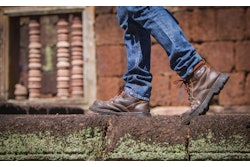
Rubber boots help provide construction workers optimal protection from mud and water, but also may lead to trench foot by trapping moisture if not properly worn and maintained. Trench foot – or immersion foot syndrome – is a condition that may occur after wearing wet socks and boots when feet are cold and wet for a long period of time, according to the Cleveland Clinic.
Most cases can develop after exposure to cold, wet conditions for one to three days, but can do so in as few as 10 to 14 hours.
Trench Foot and Rubber Boots
Restricted blood flow to the foot results from the combination of cold temperatures and moisture, affecting circulation and nerve function. Trench foot can develop in temperatures up to 60°F. Small blood vessels in the feet can start to weaken, leading to damage of surrounding tissue and skin, which can cause infection.
Excessively sweaty feet also can also cause trench foot. Those with diabetes or circulation problems may be at increased risk. Let wet feet air dry and stay dry. Do not massage the feet. Take breaks to allow feet to air out if working for an extended time period or doing strenuous work that can increase sweating.
After drying feet, wear loose-fitting footwear to enable air circulation as to avoid symptoms worsening. Ensure rubber boots are dry before wearing them again. On wet work days, aim to rotate through several pair of socks and boots to allow time for drying.
Applying anti-fungal foot powder before putting on socks can help absorb moisture and prevent further problems. Trench foot symptoms include numbness, pain, redness, burning and swelling.
Initial symptoms include tingling and itching, which can progress to numbness. Feet may feel prickly or heavy and cause walking difficulties.
Feet may be bright red, but soon turn pale, clammy and white as blood vessels narrow.
Once out of the cold, the skin of the feet will start to change color. Those with lighter skin may notice feet turning blue or purple due to poor blood flow. The discoloration won’t be as noticeable to those with darker skin.
The skin may be cold and blotchy. Swelling may occur.
Healing Process and Treatment
As the feet rewarm, they may become bright red again. Extreme pain or an abnormal sensation may occur as blood flow returns to the feet. Blisters and holes or open sores on the feet may develop, leading to fungal and bacterial infections. Skin may become overly sensitive to temperature changes and the lightest touch.
If symptoms persist or worsen, seek medical attention. A healthcare provider will ensure the symptoms are not the result of another condition such as frostbite. They may order a white blood cell count, a sed rate test – which looks for inflammation in the body – or an X-ray or a bone scan to check for bone infection.
Trench foot is treatable if caught early. Treatment includes gentle rewarming of the foot as rapid rewarming can cause severe pain and swelling. The healthcare provider also will clean the foot and keep it dry and warm. Additional treatment includes resting and elevating the foot above one’s heart to prevent new wounds and blisters.
A healthcare provider may prescribe medications and may administer a tetanus booster shot.
Long-term Outlook for Trench Foot
There may be lingering pain as full sensation returns to the foot. After treatment for trench foot, wear clean, dry socks daily. Avoid wearing socks while sleeping to keep feet dry. Feet should be checked daily to ensure symptoms aren’t worsening or a possible infection may be developing.
Those with trench foot should avoid smoking and using other products containing nicotine, which can impair blood flow to the foot. They also should eat a high protein diet and stay well hydrated.
If trench foot is left untreated, cellulitis or gangrene can set in. A severe case of gangrene may lead to the need for amputation to avoid further disease progression. Other complications may include sepsis and even death. Trench foot is preventable. Wearing the correct sized boots allows for adequate circulation and prevents excessive moisture buildup. Change out of wet socks and boots as soon as possible. Air out boots completely.
Register a free IRONPROS account today to access product search tools, connect directly with brands and more!
















